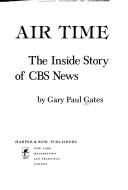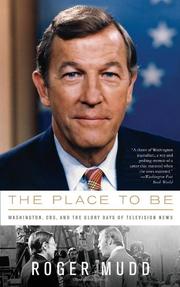| Listing 1 - 10 of 16 | << page >> |
Sort by
|

ISBN: 0060114770 Year: 1978 Publisher: New York (N.Y.): Harper and Row
Abstract | Keywords | Export | Availability | Bookmark
 Loading...
Loading...Choose an application
- Reference Manager
- EndNote
- RefWorks (Direct export to RefWorks)

ISBN: 1283139243 9786613139245 1586486551 078674541X 1586486934 1586485768 Year: 2008 Publisher: New York : PublicAffairs,
Abstract | Keywords | Export | Availability | Bookmark
 Loading...
Loading...Choose an application
- Reference Manager
- EndNote
- RefWorks (Direct export to RefWorks)
Roger Mudd joined CBS in 1961, and as the congressional correspondent, became a star covering the historic Senate filibuster debate over the 1964 Civil Right Act. Mudd was one of half a dozen major figures in the stable of CBS News broadcasters at time when the network's standing as a provider of news was at its peak. In The Place to Be, Mudd tells of how the bureau worked: the rivalries, the egos, the pride, the competition, the ambitions and the gathering frustrations of conveying the world to a national television audience in thirty minutes minus commercials. It is the story of
Television journalists --- Mudd, Roger, --- CBS News --- Columbia Broadcasting System, inc. --- CBS Inc. --- C.B.S. News --- Columbia Broadcasting System, Inc. --- CBS Corp. --- History. --- Mudd, Roger Harrison,
Book
Year: 1979 Publisher: Baarn CBS
Abstract | Keywords | Export | Availability | Bookmark
 Loading...
Loading...Choose an application
- Reference Manager
- EndNote
- RefWorks (Direct export to RefWorks)
INS Institutes --- CBS institute --- The Netherlands --- jubilee volume
Book
Year: 2001
Abstract | Keywords | Export | Availability | Bookmark
 Loading...
Loading...Choose an application
- Reference Manager
- EndNote
- RefWorks (Direct export to RefWorks)
Mass media --- Mergers --- Viacom Inc. --- Columbia Broadcasting System, inc. --- Cbs inc. --- Business & economics --- Social science
Dissertation
Year: 2016 Publisher: Liège Université de Liège (ULiège)
Abstract | Keywords | Export | Availability | Bookmark
 Loading...
Loading...Choose an application
- Reference Manager
- EndNote
- RefWorks (Direct export to RefWorks)
This research focuses on the implementation of a CBS in Luxembourg banks which represents one of the greatest transformation challenges for them. This transformation disrupts completely the IT architecture of the banks and induces high investment costs. In addition, the high rate of failure of CBS implementation projects represents a major threat for banks and does not lead them from initiating such projects. The goals pursued by this study are classified in three parts but all aim at exploring and detailing the pros and cons involved in the implementation of the CBS. External market elements such as new regulations, customer’s new requirements and disruptive technology make the operation of the activities with a legacy CBS more and more difficult. It emphasizes how the implementation of CBS represents a hot topic for a majority of banks. Therefore KPMG Luxembourg launched its KPMG Core Banking System Survey in 2016 to analyse the trends driving the Luxembourg banks concerning the CBS replacement topic and its associated implementation project. The survey provided this research with data collected from surveyed banks. Indeed, a questionnaire has been sent to the participating banks whose replies have been leveraged to answer the topics addressed in this study. In addition to the survey findings, scientific literature, i.e. articles has been analysed to respond the research questions which have allowed this thesis to draw up statements by taking into account findings of both methods. Regarding the challenges related to the implementation of a CBS, the study identified managing such a big transformation as the biggest issue for the banks. Despite the existence of such challenge and other ones mentioned in this research, banks still wants to implement a new CBS because of the benefits associated with a modern CBS. The main CBS renewal driver retrieved from the findings of this survey is to help cover business requirements. Finally, this study evaluated the performance of the current CBSs operating in the banks and the findings show that the majority of the CBSs would have difficulties to handle changes in the business activities of the banks. This study, by pointing out these findings, aims at providing better and relevant information for the banks to make their decisions for the topics related to the implementation of a CBS. Additional studies on the CBS implementation are needed to fill in the scientific resource gaps which have been identified by this study when constructing the literature review.
CBS --- Implementation --- Challenges --- Drivers --- ERP --- Automated processes --- Efficiency --- Sciences économiques & de gestion > Finance
Book
ISBN: 082627417X 9780826274175 9780826221650 0826221653 9780826221650 Year: 2018 Publisher: Columbia, Missouri
Abstract | Keywords | Export | Availability | Bookmark
 Loading...
Loading...Choose an application
- Reference Manager
- EndNote
- RefWorks (Direct export to RefWorks)
"Historian Sara Eskridge examines television's rural comedy boom in the 1960s and the political, social, and economic factors that made these shows a perfect fit for CBS. The network, nicknamed the Communist Broadcasting System during the Red Scare of the 1940s, saw its image hurt again in the 1950s with the quiz show scandals and a campaign against violence in westerns. When a rival network introduced rural-themed programs to cater to the growing southern market, CBS latched onto the trend and soon reestablished itself as the Country Broadcasting System. Its rural comedies dominated the ratings throughout the decade, attracting viewers from all parts of the country. With fascinating discussions of The Andy Griffith Show, The Beverly Hillbillies, Petticoat Junction, and other shows, Eskridge reveals how the southern image was used to both entertain and reassure Americans in the turbulent 1960s"--
PERFORMING ARTS / Television / History & Criticism. --- Popular culture --- Television programs --- Situation comedies (Television programs) --- Country life on television. --- Television --- Sitcoms (Television programs) --- Television sitcoms --- Television situation comedies --- Television comedies --- Programs, Television --- Shows, Television --- Television shows --- TV shows --- Television broadcasting --- Electronic program guides (Television) --- Television scripts --- History --- Social aspects --- History and criticism. --- CBS Television Network --- Cinema Center Films --- Columbia Broadcasting System, Inc. --- CBS Inc. --- CBS Corp. --- CBS Productions --- Columbia Broadcasting System, inc. --- CBS Television --- C.B.S. Television Network --- CBS-TV --- C.B.S.-TV --- History. --- Southern States --- American South --- American Southeast --- Dixie (U.S. : Region) --- Former Confederate States --- South, The --- Southeast (U.S.) --- Southeast United States --- Southeastern States --- Southern United States --- United States, Southern --- On television.
Book
ISBN: 9781433121838 9781433106026 1433106027 Year: 2009 Publisher: New York : Peter Lang,
Abstract | Keywords | Export | Availability | Bookmark
 Loading...
Loading...Choose an application
- Reference Manager
- EndNote
- RefWorks (Direct export to RefWorks)
Télévision --- Television broadcasting of news --- Émissions de nouvelles --- Histoire --- History --- CBS News --- History. --- #SBIB:309H523 --- #SBIB:309H1513 --- Television broadcasting --- Television coverage of news --- Television journalism --- Television news --- Broadcast journalism --- Audiovisuele communicatie: verhaalanalyse --- Geschiedenis en/of organisatie van de radio en/of televisie: algemeen en per land (met inbegrip van de rol van de omroep in de ontwikkelingsproblematiek) --- News --- Columbia Broadcasting System, inc. --- CBS Inc. --- C.B.S. News --- Columbia Broadcasting System, Inc. --- CBS Corp. --- Télévision --- Émissions de nouvelles
Book
Year: 2018 Publisher: Amsterdam : Amsterdam University Press,
Abstract | Keywords | Export | Availability | Bookmark
 Loading...
Loading...Choose an application
- Reference Manager
- EndNote
- RefWorks (Direct export to RefWorks)
Difficult as it is to imagine today, in 1937 America's two leading media companies fought over the right to perform Shakespeare for an American radio audience in an attempt to bring prestige to their networks. The resulting fourteen broadcasts are among the more remarkable recreations of Shakespeare of their time. This lively and engaging book shows the cultural dominance of radio in the 1930s, and tells the story of why the networks each wanted to lord Shakespeare's prestige over the other, how they put their series together, the critical reception, and the cultural impact and legacies of the broadcasts.
Radio plays --- Social aspects --- Shakespeare, William, --- Audio adaptations --- History and criticism. --- Adaptation. --- CBS. --- Columbia Shakespeare Cycle. --- Edward G. Robinson. --- Humphrey Bogart. --- John Barrymore. --- NBC. --- Old Time Radio. --- Orson Welles. --- Radio Shakespeare. --- Radio Summer Series.
Book
ISBN: 0520969898 9780520969896 9780520297593 9780520297609 0520297598 0520297601 Year: 2020 Publisher: Berkeley, California : University of California Press,
Abstract | Keywords | Export | Availability | Bookmark
 Loading...
Loading...Choose an application
- Reference Manager
- EndNote
- RefWorks (Direct export to RefWorks)
Studios are, at once, material environments and symbolic forms, sites of artistic creation and physical labor, and nodes in networks of resource circulation. They are architectural places that generate virtual spaces—worlds built to build worlds. Yet, despite being icons of corporate identity, studios have faded into the background of critical discourse and into the margins of film and media history. In response, In the Studio demonstrates that when we foreground these worlds, we gain new insights into moving-image culture and the dynamics that quietly mark the worlds on our screens. Spanning the twentieth century and moving globally, this unique collection tells new stories about studio icons—Pinewood, Cinecittà, Churubusco, and CBS—as well as about the experimental workplaces of filmmakers and artists from Aleksandr Medvedkin to Charles and Ray Eames and Hollis Frampton.
Motion picture studios --- History --- aleksandr medvedkin. --- architecture. --- art studio. --- artists space. --- arts production. --- brazil. --- cbs. --- charles eames. --- churubusco. --- cinecitt. --- cinema. --- creativity. --- digital arts lab. --- eames brothers. --- film history. --- film production. --- film studio. --- film. --- filmmaking. --- glass studio. --- hollis frampton. --- illumination. --- industry. --- light. --- lucasfilm. --- media history. --- media studies. --- media technologies. --- mosfilm. --- nikkatsu mukojima. --- pinewood. --- production studio. --- ray eames. --- space theory. --- studio space. --- studio system. --- technology.

ISBN: 2738457037 Year: 1997 Publisher: Paris L'Harmattan
Abstract | Keywords | Export | Availability | Bookmark
 Loading...
Loading...Choose an application
- Reference Manager
- EndNote
- RefWorks (Direct export to RefWorks)
la Croix rouge --- la guerre froide --- organisations internationales publiques --- organisations de santé à la SDN --- l'OMS --- la santé --- CBS TV --- Genève --- bureaucratie --- le SIDA --- épidémies --- GPA --- Jonathan Mann --- Michael Merson --- le programme SIDA des Nations Unies --- le NU Aids --- politique --- le Royaume du Tonga --- démocratie --- bureaucratie internationale --- l'affaire Hiroshi Nakajima --- laboratoires pharmaceutiques --- Sasakawa --- Afrique --- Monekosso --- la santé publique
| Listing 1 - 10 of 16 | << page >> |
Sort by
|

 Search
Search Feedback
Feedback About UniCat
About UniCat  Help
Help News
News